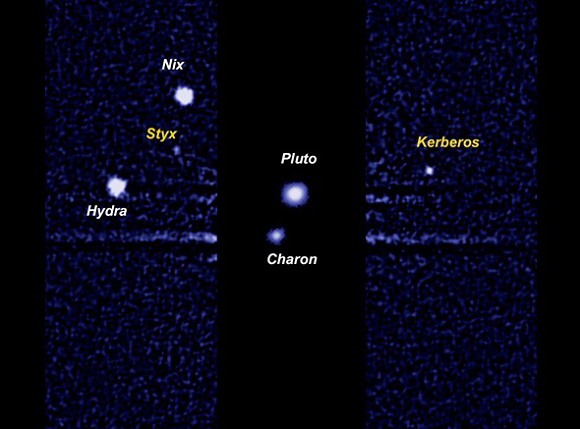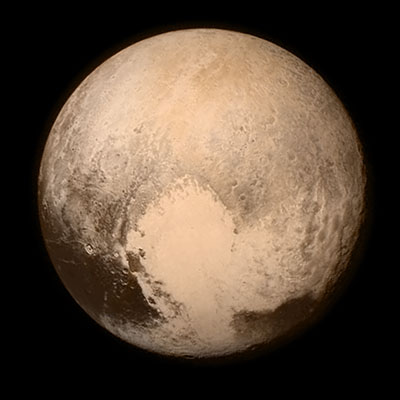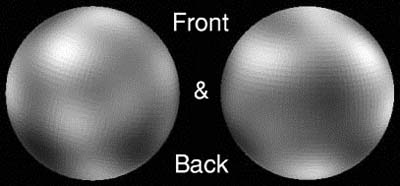Pluto
Long considered to be the smallest, coldest, and most distant planet from the Sun, now is known as Dwarf planet along with Ceres, Eris, Makemake and Haumea. Pluto may also be the largest of a group of objects that orbit in a disc-like zone of beyond the orbit of Neptune called the Kuiper Belt. This distant region consists of thousands of miniature icy worlds with diameters of at least 1,000 km and is also believed to be the source of some comets (see kuiper belt and Dwarf planets info)
Discovered by American astronomer Clyde Tombaugh in 1930, Pluto takes 248 years to orbit the Sun. Pluto's most recent close approach to the Sun was in 1989. Between 1979 and 1999, Pluto's highly elliptical orbit brought it closer to the Sun than Neptune, providing rare opportunities to study this small, cold, distant world and its companion moon, Charon.
Pluto is about two-thirds the diameter of Earth's moon and probably has a rocky core surrounded by a mantle of water ice. More exotic ices like methane and nitrogen frost coat its surface. Owing to its size and lower density, Pluto's mass is about one-sixth that of Earth's moon. Pluto is more massive than Ceres -- the dwarf planet that resides in the asteroid belt between Mars and Jupiter -- by a factor of 20.
Since its orbit is so elliptical, when Pluto is close to the sun, its surface ices thaw, rise and temporarily form a thin atmosphere. Pluto's low gravity (about 6 percent of Earth's) causes the atmosphere to be much more extended in altitude than our planet's atmosphere. Pluto becomes much colder during the part of each orbit when it is traveling far away from the sun. During this time, the bulk of the planet's atmosphere is thought to freeze.
Pluto has a very large moon that is almost half its size named Charon, which was discovered in 1978. This moon is so big that Pluto and Charon are sometimes referred to as a double dwarf planet system. The distance between them is 19,640 km (12,200 miles). The Hubble Space Telescope photographed Pluto and Charon in 1994 when Pluto was about 30 AU from Earth. These photos showed that Charon is grayer than Pluto (which is red), indicating that they have different surface compositions and structure.
Charon's orbit around Pluto takes 6.4 Earth days, and one Pluto rotation (a Pluto day) takes 6.4 Earth days. Charon neither rises nor sets, but hovers over the same spot on Pluto's surface, and the same side of Charon always faces Pluto -- this is called tidal locking. Compared with most of the planets and moons, the Pluto-Charon system is tipped on its side, like Uranus. Pluto's rotation is retrograde: it rotates backwards, from east to west (Uranus and Venus also have retrograde rotations).
It isn't known whether Pluto has a magnetic field, but its small size and slow rotation suggest little or no magnetic field.
Because Pluto and Charon are so small and far away, they are extremely difficult to observe from Earth. In the late 1980s, Pluto and Charon passed in front of each other repeatedly for several years. Observations of these rare events allowed astronomers to make rudimentary maps of each body showing areas of relative brightness and darkness.
In 2005, scientists photographing Pluto with the Hubble Space Telescope in preparation for the New Horizons mission found two tiny moons orbiting in the same plane as Charon. These two moons, named Nix and Hydra, are two to three times farther away from Pluto than Charon.
In 2011 and 2012, scientists used Hubble to spot two more moons (originally designated P4 and P5). In 2013, the two moons were named Kerberos (P4) and Styx (P5).
Pluto is the only world named by an 11-year-old girl. In 1930, Venetia Burney of Oxford, England, suggested to her grandfather that the new discovery be named for the Roman god the underworld. He forwarded the name to the Lowell Observatory and it was selected. Pluto's moons are named for other mythological figures associated with the underworld. Charon is named for the river Styx boatman who ferries souls in the underworld; Nix is named for the mother of Charon, who is also the goddess of darkness and night; Hydra is named for the nine-headed serpent that guards the underworld; Kerberos is named after the three-headed dog of Greek mythology; and Styx is named for the mythological river that separates the world of the living from the realm of the dead.
NASA's New Horizons space probe, launched in 2006, made its maximum approach to Pluto on July 14, 2015. It sent the first detailed photographs of the Planet and its 5 moons like the one shown above on the left. In it dominates the large, bright feature informally named the “heart,” which measures approximately 1,000 miles (1,600 kilometers) across. The heart borders darker equatorial terrains, and the mottled terrain to its east are complex. However, even at this resolution, much of the heart’s interior appears remarkably featureless, and it turns out to be the area with the lowest surface height.
| Pluto facts | |
Ninth planet from the Sun and ninth in size |
|
| Discovered by | Clyde Tombaugh |
| Year of discovery | 1930 |
| Average distance to the sun | 5,906 million km |
| Diameter | 2,302 km |
| Mass | 1.3 x 10²² kg |
| Density | 2.05 g/cm³ |
| Surface gravity | 0.66 m/s² |
| Axial period | -6.375 days |
| Axial inclination | 122.5° |
| Orbital period | 247.92 years |
| Orbital inclination | 17.14° |
| Orbital eccentricity | 0.248 |
| Mean temperature | -230 °C |
| Escape velocity | 4,428 km/h |
| Albedo | 0.4 |
| Atmospheric composition | 98% N2 |
| Moons | 1. Charon |

A Hubble Space Telescope image of Pluto and its moons. Charon is the largest moon close to Pluto. The other four bright dots are smaller moons discovered in 2005, 2011 and 2012.
Information from: SSE-JPL-NASA and David Darling's encyclopedia


